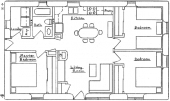posted 2 years ago
This is interesting but if this is for you I'd have to ask how much power do you really need? The average single family detached home uses about 40kwh of energy per day, the bulk of which goes to heat and AC. I think if you make some other energy efficient changes like heating yourself not the room, using fans, etc, then the 10kw solar system might be fine for most people's needs.
I think for scoring this system from a permaculture perspective I give it (1 is bad, 10 is best):
Self reliance factor: 1 the temperatures and equipment involved seem very complicated so only large entities could operate it
Complexity factor: 2 not as complicated as nuclear but still a lot of components
Pollution factor: 5 the materials seem exotic and with the high temperature may break often (fact check me on this)
Cost factor: 3 extra equipment seems expensive and expensive to maintain and keep safe
Versatility factor: 10 it does involve electricity and heat so pretty versatile energy currency









